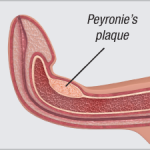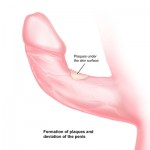What is Peyronie’s Disease?
Peyronie’s disease is a condition characterized by the development of scar tissue, known as plaque, within the penis. This plaque typically forms on the top or bottom part of the penis, causing it to curve or bend. The condition can lead to pain during sexual intercourse and may even result in difficulty engaging in sexual activity. It’s important to note that Peyronie’s disease is not caused by infection or cancer, and it is not contagious.
How is Peyronie’s Disease Diagnosed?

If you’re experiencing a curvature or bend in your penis that is affecting your sexual function, including pain during erection, it’s essential to consult a specialist in male genitourinary tract diseases, such as a urologist. In New York City, Dr. Yaniv Larish, a renowned urologist, can diagnose Peyronie’s disease through a comprehensive evaluation. This process typically involves taking your medical history, performing a physical examination, and utilizing imaging techniques like X-rays or ultrasounds to obtain images of the plaque.
Is Exercise and Massage an Option for Treatment?
When it comes to treating Peyronie’s disease, Dr. Larish may recommend various approaches to address the condition’s symptoms and minimize its impact on your sexual function. Medications may be prescribed to reduce plaque size, decrease inflammation, and alleviate curvature of the penis. Some medications are taken orally, while others may be injected directly into the plaque itself.
 Exercise and massage also play a crucial role in the treatment of Peyronie’s disease. These techniques can help reduce the curvature of the penis and soften the plaque. Stretching exercises, specifically, have shown promising results. To perform these exercises, start by placing a warm towel on your penis for five minutes to improve blood flow. Then, Dr. Larish recommends two common stretching exercises:
Exercise and massage also play a crucial role in the treatment of Peyronie’s disease. These techniques can help reduce the curvature of the penis and soften the plaque. Stretching exercises, specifically, have shown promising results. To perform these exercises, start by placing a warm towel on your penis for five minutes to improve blood flow. Then, Dr. Larish recommends two common stretching exercises:
- The first exercise involves grasping the penis behind the head and pulling it away from your body for 10-15 seconds before slowly releasing it. Repeat this exercise in different directions, stretching the penis upward, downward, to the right, and to the left. Alternatively, you can apply pressure to a flaccid penis and pull it outward as far as you can, holding it for five minutes in each direction.
- The second exercise is called the “milking exercise.” Start by massaging the penis until you achieve an erection. Form an “OK” sign with your thumb and forefinger and grip the base of the penis. Move your hand up and down between the base and the tip, applying gentle pressure. Repeat this motion ten times and then take a rest.
Massage techniques using a lubricant after exercising can further enhance the results for individuals with Peyronie’s disease. If you’re struggling with this condition, don’t hesitate to contact Dr. Yaniv Larish, one of New York’s top urologists, and schedule an appointment to discuss your options for treatment.
FIFTH AVENUE UROLOGY
4 East 76th Street
New York, NY 10021
Phone: 212-675-3186
Website: https://www.fifthavenueurology.com/

Just so you know injury to the penis IS NOT THE ONLY WAY TO GET THIS Disease…. My husband developed this AFTER he had hernia surgery. And I mean AFTER SURGERY. And I know a few more males that this has happened to. So add that to your list….
This happened to my late father as well. He described the issue and was never the same post surgery. My mother recently told me his function post surgery was never the same. I always wondered if it had something to do with the mesh they used.
Yes I developed this disease after my hernia surgery. I found it odd that it never mentioned that.
I believe that pinching my penis to build up pressure to urinate in a straight line somehow created a fissure inside my penis to cause this scar tissue.
the bladder is a low pressure devise and as I have aged the pressure has gotten even lower leading me to urinate in all directions but the direction I want; so, I would pinch to build up pressure….
I stopped doing that. Now Trying to deal with Peyronie’s now that I know what it is.
Hope this is helpful to someone somewhere.
I also had mesh hernia surgery. Coincidence? After my surgery I was unable to orgasm as it was the most intense pain I’ve ever felt. I believe scar tissue from hernia surgery can cause Peyronie’s.
I have Dupuytren’s Contracture on my hand, which I’ve had to have treated with Xiaplex injections. I later developed Peyronie’s, which is the same condition on the penis. My urologist says the two are 100% related. It may be genetic in my case. The Xiaplex on my hand was successful, and I’m considering the same treatment for my penis.